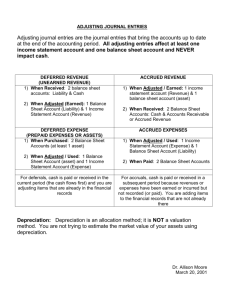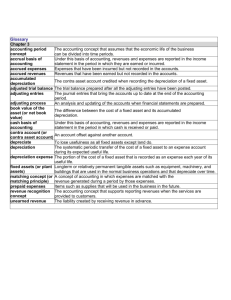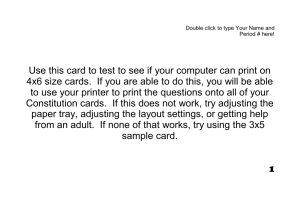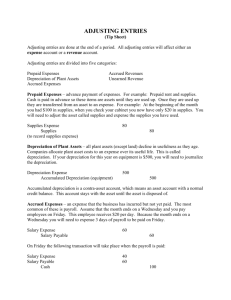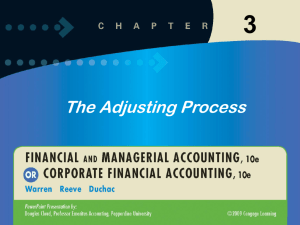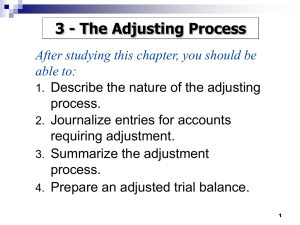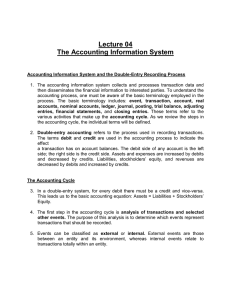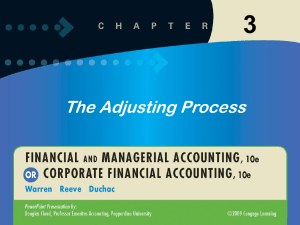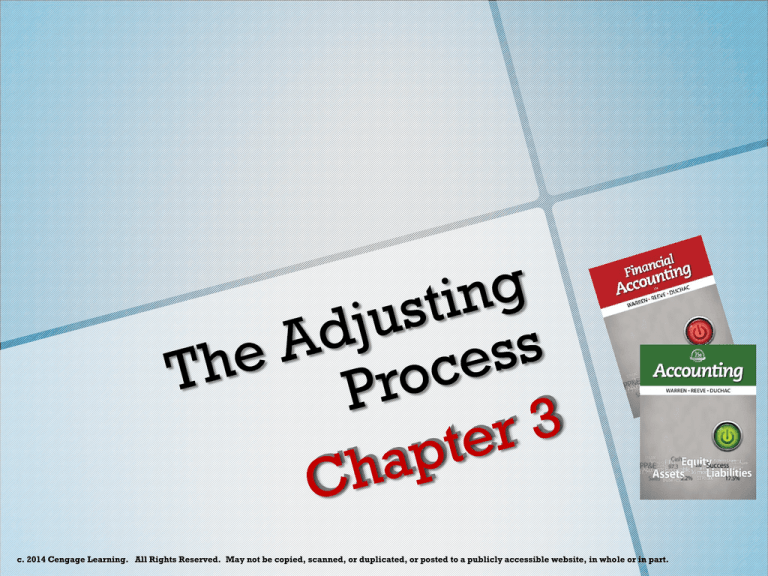
c. 2014 Cengage Learning. All Rights Reserved. May not be copied, scanned, or duplicated, or posted to a publicly accessible website, in whole or in part.
Learning Objectives
1.
2.
Describe the nature of the adjusting process.
3.
4.
5.
Summarize the adjustment process.
Journalize entries for accounts requiring
adjustment.
Prepare an adjusted trial balance.
Describe and illustrate the use of vertical
analysis in evaluating a company’s
performance and financial condition.
c. 2014 Cengage Learning. All Rights Reserved. May not be copied, scanned, or duplicated, or posted to a publicly accessible website, in whole or in part.
Nature of the Adjusting Process
o The accounting period concept requires that
revenues and expenses be reported in the
proper period.
Nature of the Adjusting Process
o Under the accrual basis of accounting,
revenues are reported on the income
statement in the period in which they are
earned.
Nature of the Adjusting Process
o The accounting concept supporting the
reporting of revenues when they are earned
regardless of when cash is received is called
the revenue recognition concept.
Nature of the Adjusting Process
o The accounting concept supporting reporting
revenues and related expenses in the same
period is called the matching concept, or
matching principle.
Nature of the Adjusting Process
o Under the cash basis of accounting, revenues
and expenses are reported on the income
statement in the period in which cash is
received or paid.
The Adjusting Process
o Under the accrual basis, some of the accounts
need updating at the end of the accounting
period for the following reasons:
Some expenses are not recorded daily.
Some revenues and expenses are incurred as time
passes rather than as separate transactions.
Some revenues and expenses may be unrecorded.
The Adjusting Process
o The analysis and updating of accounts at the
end of the period before the financial
statements are prepared is called the adjusting
process.
The Adjusting Process
o The analysis and updating of accounts at the
end of the period before the financial
statements are prepared is called the adjusting
process.
o The journal entries that bring the accounts up
to date at the end of the accounting period are
called adjusting entries.
Types of Accounts Requiring Adjustment
o Prepaid expenses are the advance payment of
future expenses and are recorded as assets
when cash is paid.
PREPAID EXPENSES
(continued)
PREPAID EXPENSES
(concluded)
Types of Accounts Requiring Adjustment
o Unearned revenues are the advance receipt of
future revenues and are recorded as liabilities
when cash is received.
UNEARNED
REVENUES
(continued)
UNEARNED
REVENUES
(concluded)
Types of Accounts Requiring Adjustment
o Accrued revenues are unrecorded revenues
that have been earned and for which cash has
yet to be received.
ACCRUED
REVENUES
(continued)
ACCRUED
REVENUES
(concluded)
Types of Accounts Requiring Adjustment
o Accrued expenses are unrecorded expenses
that have been incurred and for which cash has
yet to be paid.
ACCRUED EXPENSES
(continued)
ACCRUED EXPENSES
(concluded)
c. 2014 Cengage Learning. All Rights Reserved. May not be copied, scanned, or duplicated, or posted to a publicly accessible website, in whole or in part.
ADJUSTING ENTRIES
ADJUSTING ENTRIES
Prepaid Expenses
o NetSolutions’ supplies account has a balance of
$2,000 on the unadjusted trial balance. Some of
these supplies have been used. On December
31, a count reveals that the amount of supplies
on hand is $760.
Supplies (balance on trial balance) $2,000
Supplies on hand, December 31
– 760
Supplies used
$1,240
PREPAID EXPENSES
Accounting Equation Impact
Assets
=
Liabilities
+
increase
decrease
Owner’s Equity (Expense)
Prepaid Insurance
o The debit balance of $2,400 in NetSolutions’
prepaid insurance account represents the
December 1 prepayment of insurance for 12
months.
PREPAID
INSURANCE
Accounting Equation Impact
Assets
=
Liabilities
+
increase
decrease
Owner’s Equity (Expense)
Impact of Omitting Adjusting Entries
Unearned Revenues
o The credit balance of $360 in NetSolutions’
unearned rent account represents the receipt
of three months’ rent on December 1 for
December, January, and February. At the end of
December, one month’s rent has been earned.
UNEARNED
REVENUES
Accounting Equation Impact
Assets
=
Liabilities
+
Owner’s Equity (Revenue)
increase
decrease
Impact of Omitting Adjusting Entry
Accrued Revenues
o NetSolutions signed an agreement with Danker
Co. on December 15 to provide services at a
rate of $20 per hour. As of December 31,
NetSolutions had provided 25 hours of
services. The revenue will be billed on January
15.
UNEARNED
REVENUES
Accounting Equation Impact
Assets
=
increase
Liabilities
+
Owner’s Equity (Revenue)
increase
Impact of Omitting Adjusting Entry
Accrued Expenses: Accrued Wages
Accrued Wages
o NetSolutions pays it employees biweekly.
During December, NetSolutions paid wages of
$950 on December 13 and $1,200 on
December 27. As of December 31,
NetSolutions owes $250 of wages to employees
for Monday and Tuesday, December 30 and 31.
ACCRUED WAGES
Accounting Equation Impact
Assets
=
Liabilities
increase
+
Owner’s Equity (Expense)
increase
Accrued Wages
o NetSolutions paid wages of $1,275 on January
10. This payment includes the $250 of accrued
wages recorded on December 31.
IMPACT OF
OMITTING
ADJUSTING ENTRY
Depreciation Expense
o Fixed assets, or plant assets, are physical
resources that are owned and used by a
business and are permanent or have a long
life.
o As time passes, a fixed asset loses its ability to
provide useful services. This decrease in
usefulness is called depreciation.
Depreciation Expense
o All fixed assets, except land, lose their
usefulness and , thus, are said to depreciate.
o As a fixed asset depreciates, a portion of its
cost should be recorded as an expense. This
periodic expense is called depreciation
expense.
Depreciation Expense
o The fixed asset account is not decreased
(credited) when making the related adjusting
entry. This is because both the original cost of
a fixed asset and the depreciation recorded
since its purchase are reported on the balance
sheet. Instead, an account entitled
Accumulated Depreciation is increased
(credited).
o Accumulated depreciation accounts are called
contra accounts, or contra asset accounts.
Depreciation Expense
o Normal titles for fixed asset accounts and their
related contra asset accounts are as follows:
Depreciation Expense
o NetSolutions estimates the depreciation on its
office equipment to be $50 for the month of
December.
DEPRECIATION
EXPENSE
Accounting Equation Impact
Assets
=
Liabilities
+
Owner’s Equity (Expense)
increase
increase
Depreciation Expense
o The difference between the original cost of the
office equipment and the balance in the
accumulated depreciation—office equipment
account is called the book value of the asset
(or net book value). It is computed as shown
below.
Book Value of Asset
= Cost of the Asset – Accumulated Depreciation of Asset
Book Value of Off. Equip. = Cost of Off. Equip. – Acc. Deprec. of Office Equip.
Book Value of Off. Equip. = $1,800 – $50
Book Value of Off. Equip. = $1,750
IMPACT OF
OMITTING
ADJUSTING ENTRY
c. 2014 Cengage Learning. All Rights Reserved. May not be copied, scanned, or duplicated, or posted to a publicly accessible website, in whole or in part.
SUMMARY OF
ADJUSTMENT
PROCESS
(continued)
SUMMARY OF
ADJUSTMENT
PROCESS
(continued)
SUMMARY OF
ADJUSTMENT
PROCESS
(continued)
SUMMARY OF
ADJUSTMENT
PROCESS
(continued)
SUMMARY OF
ADJUSTMENT
PROCESS
(concluded)
ADJUSTING ENTRIES
ADJUSTING ENTRIES
LEDGER WITH
ADJUSTING ENTRIES
(continued)
LEDGER WITH
ADJUSTING
ENTRIES
LEDGER WITH
ADJUSTING ENTRIES
c. 2014 Cengage Learning. All Rights Reserved. May not be copied, scanned, or duplicated, or posted to a publicly accessible website, in whole or in part.
Adjusted Trial Balance
o The purpose of the adjusted trial balance is to
verify the equality of the total debit and credit
balances before the financial statements are
prepared.
ADJUSTED TRIAL
BALANCE
c. 2014 Cengage Learning. All Rights Reserved. May not be copied, scanned, or duplicated, or posted to a publicly accessible website, in whole or in part.
Vertical Analysis
o Comparing each item in a financial statement
with a total amount from the same statement is
referred to as vertical analysis.
Vertical Analysis
$12,500
$187,500
= .067 or 6.7%
Vertical Analysis
$3,000
$150,000
= .02 or 2%
c. 2014 Cengage Learning. All Rights Reserved. May not be copied, scanned, or duplicated, or posted to a publicly accessible website, in whole or in part.

